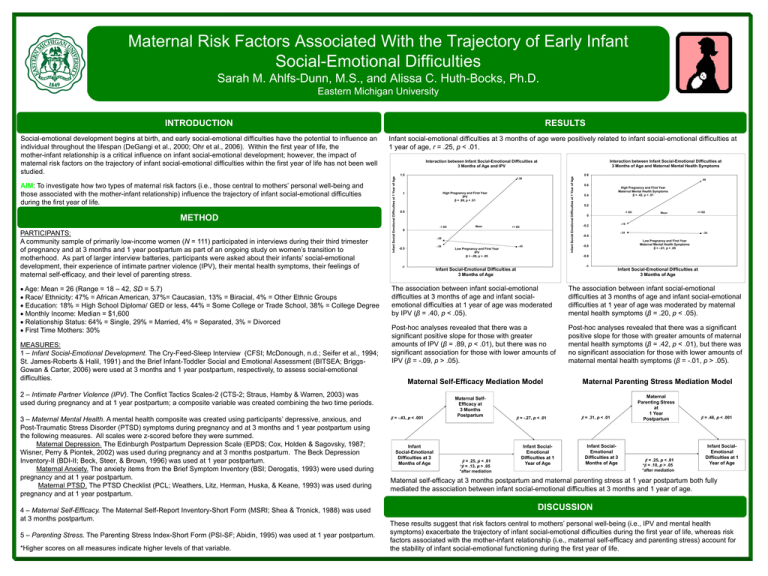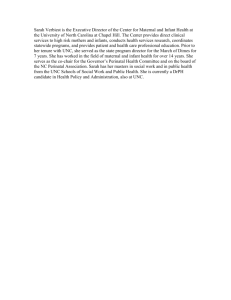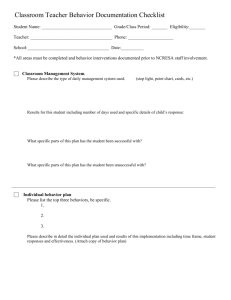Maternal Risk Factors Associated With the Trajectory of Early Infant
advertisement

Maternal Risk Factors Associated With the Trajectory of Early Infant Social-Emotional Difficulties Sarah M. Ahlfs-Dunn, M.S., and Alissa C. Huth-Bocks, Ph.D. Eastern Michigan University INTRODUCTION METHOD PARTICIPANTS: A community sample of primarily low-income women (N = 111) participated in interviews during their third trimester of pregnancy and at 3 months and 1 year postpartum as part of an ongoing study on women’s transition to motherhood. As part of larger interview batteries, participants were asked about their infants’ social-emotional development, their experience of intimate partner violence (IPV), their mental health symptoms, their feelings of maternal self-efficacy, and their level of parenting stress. Age: Mean = 26 (Range = 18 – 42, SD = 5.7) Race/ Ethnicity: 47% = African American, 37%= Caucasian, 13% = Biracial, 4% = Other Ethnic Groups Education: 18% = High School Diploma/ GED or less, 44% = Some College or Trade School, 38% = College Degree Monthly Income: Median = $1,600 Relationship Status: 64% = Single, 29% = Married, 4% = Separated, 3% = Divorced First Time Mothers: 30% MEASURES: 1 – Infant Social-Emotional Development. The Cry-Feed-Sleep Interview (CFSI; McDonough, n.d.; Seifer et al., 1994; St. James-Roberts & Halil, 1991) and the Brief Infant-Toddler Social and Emotional Assessment (BITSEA; BriggsGowan & Carter, 2006) were used at 3 months and 1 year postpartum, respectively, to assess social-emotional difficulties. 1.5 1.38 High Pregnancy and First Year IPV β = .89, p < .01 1 0.5 4 – Maternal Self-Efficacy. The Maternal Self-Report Inventory-Short Form (MSRI; Shea & Tronick, 1988) was used at 3 months postpartum. 5 – Parenting Stress. The Parenting Stress Index-Short Form (PSI-SF; Abidin, 1995) was used at 1 year postpartum. *Higher scores on all measures indicate higher levels of that variable. Mean -1 SD +1 SD 0 -.28 -.39 -0.5 -1 Low Pregnancy and First Year IPV β = -.09, p > .05 -.45 0.8 .68 0.6 High Pregnancy and First Year Maternal Mental Health Symptoms β = .42, p < .01 0.4 0.2 -1 SD 0 Mean +1 SD -.16 -0.2 -.34 -.35 -0.4 Low Pregnancy and First Year Maternal Mental Health Symptoms β = -.01, p > .05 -0.6 -0.8 -1 Infant Social-Emotional Difficulties at 3 Months of Age Infant Social-Emotional Difficulties at 3 Months of Age The association between infant social-emotional difficulties at 3 months of age and infant socialemotional difficulties at 1 year of age was moderated by IPV (β = .40, p < .05). The association between infant social-emotional difficulties at 3 months of age and infant social-emotional difficulties at 1 year of age was moderated by maternal mental health symptoms (β = .20, p < .05). Post-hoc analyses revealed that there was a significant positive slope for those with greater amounts of IPV (β = .89, p < .01), but there was no significant association for those with lower amounts of IPV (β = -.09, p > .05). Post-hoc analyses revealed that there was a significant positive slope for those with greater amounts of maternal mental health symptoms (β = .42, p < .01), but there was no significant association for those with lower amounts of maternal mental health symptoms (β = -.01, p > .05). Maternal Self-Efficacy Mediation Model 2 – Intimate Partner Violence (IPV). The Conflict Tactics Scales-2 (CTS-2; Straus, Hamby & Warren, 2003) was used during pregnancy and at 1 year postpartum; a composite variable was created combining the two time periods. 3 – Maternal Mental Health. A mental health composite was created using participants’ depressive, anxious, and Post-Traumatic Stress Disorder (PTSD) symptoms during pregnancy and at 3 months and 1 year postpartum using the following measures. All scales were z-scored before they were summed. Maternal Depression. The Edinburgh Postpartum Depression Scale (EPDS; Cox, Holden & Sagovsky, 1987; Wisner, Perry & Piontek, 2002) was used during pregnancy and at 3 months postpartum. The Beck Depression Inventory-II (BDI-II; Beck, Steer, & Brown, 1996) was used at 1 year postpartum. Maternal Anxiety. The anxiety items from the Brief Symptom Inventory (BSI; Derogatis, 1993) were used during pregnancy and at 1 year postpartum. Maternal PTSD. The PTSD Checklist (PCL; Weathers, Litz, Herman, Huska, & Keane, 1993) was used during pregnancy and at 1 year postpartum. Interaction between Infant Social-Emotional Difficulties at 3 Months of Age and Maternal Mental Health Symptoms Interaction between Infant Social-Emotional Difficulties at 3 Months of Age and IPV Infant Social Emotional Difficulties at 1 Year of Age AIM: To investigate how two types of maternal risk factors (i.e., those central to mothers’ personal well-being and those associated with the mother-infant relationship) influence the trajectory of infant social-emotional difficulties during the first year of life. Infant social-emotional difficulties at 3 months of age were positively related to infant social-emotional difficulties at 1 year of age, r = .25, p < .01. Infant Social Emotional Difficulties at 1 Year of Age Social-emotional development begins at birth, and early social-emotional difficulties have the potential to influence an individual throughout the lifespan (DeGangi et al., 2000; Ohr et al., 2006). Within the first year of life, the mother-infant relationship is a critical influence on infant social-emotional development; however, the impact of maternal risk factors on the trajectory of infant social-emotional difficulties within the first year of life has not been well studied. RESULTS β = -.43, p < .001 Infant Social-Emotional Difficulties at 3 Months of Age Maternal SelfEfficacy at 3 Months Postpartum 2 . β = .25, p < .01 *β = .13, p > .05 *after mediation β = -.27, p < .01 Infant SocialEmotional Difficulties at 1 Year of Age Maternal Parenting Stress Mediation Model β = .31, p < .01 Infant SocialEmotional Difficulties at 3 Months of Age Maternal Parenting Stress at 1 Year . Postpartum β = .25, p < .01 *β = .10, p > .05 *after mediation β = .46, p < .001 Infant SocialEmotional Difficulties at 1 Year of Age Maternal self-efficacy at 3 months postpartum and maternal parenting stress at 1 year postpartum both fully mediated the association between infant social-emotional difficulties at 3 months and 1 year of age. DISCUSSION These results suggest that risk factors central to mothers’ personal well-being (i.e., IPV and mental health symptoms) exacerbate the trajectory of infant social-emotional difficulties during the first year of life, whereas risk factors associated with the mother-infant relationship (i.e., maternal self-efficacy and parenting stress) account for the stability of infant social-emotional functioning during the first year of life.






